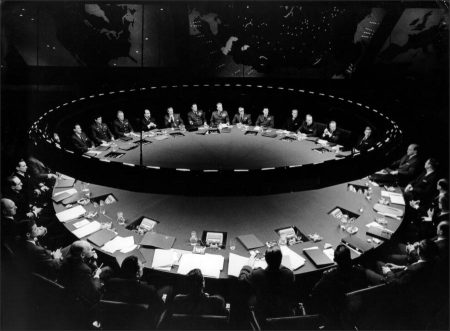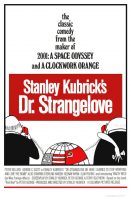Tagline: The wild hot-line suspense comedy.
Dr. Strangelove movie storyline. Paranoid Brigadier General Jack D. Ripper of Burpelson Air Force Base, believing that fluoridation of the American water supply is a Soviet plot to poison the U.S. populace, is able to deploy through a back door mechanism a nuclear attack on the Soviet Union without the knowledge of his superiors, including the Chair of the Joint Chiefs of Staff, General Buck Turgidson, and President Merkin Muffley.
Only Ripper knows the code to recall the B-52 bombers and he has shut down communication in and out of Burpelson as a measure to protect this attack. Ripper’s executive officer, RAF Group Captain Lionel Mandrake (on exchange from Britain), who is being held at Burpelson by Ripper, believes he knows the recall codes if he can only get a message to the outside world.
Meanwhile at the Pentagon War Room, key persons including Muffley, Turgidson and nuclear scientist and adviser, a former Nazi named Dr. Strangelove, are discussing measures to stop the attack or mitigate its blow-up into an all out nuclear war with the Soviets. Against Turgidson’s wishes, Muffley brings Soviet Ambassador Alexi de Sadesky into the War Room, and get his boss, Soviet Premier Dimitri Kisov, on the hot line to inform him of what’s going on.
The Americans in the War Room are dismayed to learn that the Soviets have an as yet unannounced Doomsday Device to detonate if any of their key targets are hit. As Ripper, Mandrake and those in the War Room try and work the situation to their end goal, Major T.J. “King” Kong, one of the B-52 bomber pilots, is working on his own agenda of deploying his bomb where ever he can on enemy soil if he can’t make it to his intended target.
Dr. Strangelove (1964) is the leading producer / director Stanley Kubrick’s brilliant, Doomsday satirical, provocative black comedy / fantasy regarding policy and the Cold War that has an accident, inadvertently, preemptive nuclear attack. The undated film history – the first commercial success, political satire on nuclear war, has inevitably been compared to another thriller similar published at the same time – well over-serious and melodramatic Fail-Safe (1964). However, it was a cynical objective response, Monty Python-esque, humorous, biting the apocalyptic fears of the 1950s.
The scenario of mind, co-written by the director (with Terry Southern), was based on the novel by Peter George’s Red Alert (the U.S. title). work [George’s, under his pseudonym Peter Bryant, was published in England with the title of two hours for Doom. Early versions of the script were titled Edge of Doom and the delicate balance of terror.] The novel’s main concern was the threat of accidental nuclear war.
Dr. Strangelove himself does not appear in the novel, however – it was added by Kubrick and co-writer of the South. The nightmarish mid-1960s the film, its apocalyptic theme of how technology had gone haywire and had dominated humanity. fears of anti-war film actually became a plausible scenario, shortly after the assassination of President Kennedy’s Bay of Pigs and the intensification heated up the Cold War and nuclear arms race. [Release of satirical film was delayed for 12 December 1963 to late January 1964, because of the assassination of Kennedy in late November.]
Dr. Strangelove (1964)
Directed by: Stanley Kubrick
Starring: Peter Sellers, George C. Scott, Sterling Hayden, Keenan Wynn, Slim Pickens, Tracy Reed, Jack Creley, Frank Berry, Robert O’Neil, Glenn Beck, Shane Rimmer, Roy Stephens, Hal Galili
Screenplay by: Stanley Kubrick, Terry Southern, Peter George
Production Design by: Ken Adam
Cinematography by: Gilbert Taylor
Film Editing by: Anthony Harvey
Art Direction by: Peter Murton
Makeup Department: Stuart Freeborn, Barbara Ritchie
Music by: Laurie Johnson
MPAA Rating: PG for thematic elements, some violent content, sexual humor and mild language.
Distributed by: Columbia Pictures
Release Date: January 29, 1964
Visits: 868

